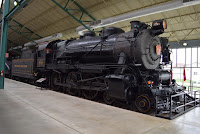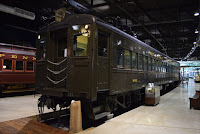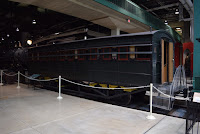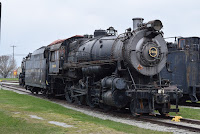Frank writes...
From Wednesday to Sunday last week I was in Strasburg, Pennsylvania at the spring conference of the Heritage Rail Alliance, nee ATRRM, nee ARM. This was the first of these conferences I've attended as a legitimate participant; the only other two I've been to were at IRM and I was just there to help keep the trains running (or, in the case of the 1993 one, to irritate my father). I made the trip with fellow blogger and IRM Western Correspondent David Wilkins.
The Railroad Museum of Pennsylvania is a state-funded railroad museum that was created in the 1970s. The core of the original museum was the historic collection of the Pennsylvania Railroad, a company which did a much better job than most of preserving its own history. The entrance to the museum, shown above, gives you a good idea of the grandeur you'd expect from government money. It also gives you a good idea of how deep in Amish country this is.
The museum is extremely well laid-out. The main exhibition hall has two halves; the eastern half is part of the original museum while the western half was added in the 1990s and is amply lit by skylights. The aisles are wide, probably 20' or so between trains (more like 30' centers), and there are some large gaps between trains to allow you to stand back and admire the equipment. Nearly all of the equipment, by the way, is meticulously restored.
When you first enter, you walk across the first through track between the pilots of two remarkably handsome steam engines. On your left (above) is Pennsylvania Railroad 7002, one of only about half a dozen standard gauge Atlantic 4-4-2 locomotives preserved in the U.S. (and one of two at this museum). Built in 1902, this engine was actually PRR 8063 but was renumbered 7002 for display at the 1939 New York World's Fair to stand in for the actual 7002, which had been scrapped. The original 7002 was reputed to be the world's fastest locomotive.
And on your right (above) is Pennsylvania Railroad 1223, a 4-4-0 passenger engine built in 1905 and retired from regular service in 1937. This engine is at the head of a short train of wooden passenger cars and sits in the older part of the building. Along the wall, alongside the train, is a faux station platform and a series of false fronts representing depot exteriors. Behind the windows are a small movie theater and a room with a model railroad setup. There are several complete trains set up in the exhibition hall and the effect is remarkably impressive.
The first car in the train, of which I didn't get a photo, is a baggage car. the second car is Pennsylvania Railroad 8177, an 1896 coach built in the railroad's shops. It's a beautiful car and is a rare example of a narrow vestibule car. The car was put into MOW service sometime in the early 1900s but was rescued and restored by the Pennsy in 1939 for display at the World's Fair.
And bringing up the markers on the wood train is Pennsylvania Railroad 3556, a beautiful open-platform coach built by the PRR in 1886. This car was retired way back in 1915, replaced by a P70 steel car, and served in MOW service until plucked from obscurity and restored in 1939 alongside car 8177. Note how the tracks in this older half of the exhibition building are curved, which I really like as it means the end of the train is just out of sight. What a great display.
Two tracks over from the wooden passenger train is the steel passenger train, four cars long, headed by Pennsylvania Railroad 4935. I know I've read something about this locomotive type but I can't remember what it's called offhand.
The steel train is less interesting to me than the wood train, with the first car a steel arch-roof baggage car, the third car a P70 commuter coach, and the rear car an observation. But the second car, shown here, is Pennsylvania Railroad 1651, which is quite an historic piece. It was built in 1906 by the Pennsy as their first steel passenger car. Along with one other prototype it paved the way for the P70 design of a year or two later. This is a relatively heavy car, as the PRR was just learning how to economize on weight with steel. It ran into the 1930s and was set aside for preservation.
Among the other interesting ephemera spread lightly around the aisles in the exhibition hall is this interesting vignette of a platform tractor towing some baggage trailers alongside the steel baggage car. Scenes like this, once ubiquitous, really enhance the effect in the exhibition hall.
Straight ahead of the GG-1, on the same track but in the new half of the building, is Pennsylvania Railroad 4465. This is an E44 type electric locomotive built in 1963 and is the sole surviving example of the last series of electric freight locomotives built in the U.S. for common carrier freight service. It's at the head of a short train of relatively modern (1950s-1960s) freight cars, including a couple of PRR paint and one in Penn Central livery.
When I think 2846 I think South Chicago City Railway, but this 2846 is a good deal heavier than IRM's version. This one is a PRR H6 2-8-0 built in 1905 by Baldwin. The Pennsy had an amazing 2,029 H6 locomotives and for a time it was the most common freight hauler on the railroad. It was retired in 1956 and later added to the PRR historic collection. It is displayed one track over from the steel passenger train, hauling a train of older, mostly wood, freight cars.
I'll snap a photo of just about anything built out of wood. This Lehigh Valley boxcar was built in 1930 and trails a steel PRR hopper car coupled to the H6. The hopper car, which I'm afraid I failed to get a photo of, is actually a pretty significant pioneering example of an all-steel hopper. The Pennsy was a pioneer with steel hopper cars, building thousands while many railroads continued to use gondolas to haul coal.
This boxcar, from the Delaware & Hudson, is a bit older. It was built in 1907 by ACF and lasted in service for an amazing 65-odd years, in MOW service in later years. It still has arch-bar trucks which were banned from interchange around WWII, if memory serves, so it must have spent a good 30 years in MOW service. It was restored by the D&H and donated to the museum in 1974.
You'll note in the above photo that the D&H car has steps up to its door. The museum has done something that I think is awfully neat; they've set up and lit the car's interior with some displays of typical goods hauled by boxcar. The interior is basically unrestored. This is a pretty neat idea if I do say so myself.
Next to the D&H car is this wooden FGEX reefer which has been very nicely restored. I'm not sure but I'd assume that IRM's FGEX reefer, acquired just a couple of years ago, would have looked pretty similar in service. Note the dummy up on the roof (no, not an HRA attendee, an actual mannequin).
And here's the FGEX reefer interior, which like the D&H car is set up as a display although you can't walk into this. Yes, that mannequin is just as creepy in person as it looks in this photo. Admittedly the lighting in this car is a bit odd.
The exhibition hall doesn't only consist of entire train sets; it also includes smaller sets and standalone locomotive and car displays. The old section of the exhibition hall has four gently curved tracks, but in the new section that is expanded to six straight tracks with the addition of switches off of the outer sides of the outer tracks. At the end of one of these tracks is Virginia & Truckee 20, the "Tahoe." This is a 2-6-0 built 1875 by Baldwin. It was acquired by the museum in the late 1960s and was restored to this, an approximation of its as-built appearance, in the Strasburg Railroad shops at that time. A sign on the locomotive stated that more recent research has turned up evidence that its as-built livery was even more elaborate than this and that at some point in the future its paint job will be redone to reflect this.
Behind V&T 20 is Cumberland Valley combine B, shown here. This is an old car - it was apparently built about 1855 and was retired from regular service in the early 1900s. The car was restored for the Chicago Railroad Fair in 1948. The display sign said that evidence suggests it was built as a coach, or possibly as a more conventional combine, and later on that unusual offset "veranda" was added.
There are three G5 class 4-6-0 locomotives in existence and this is the only one lettered for the Pennsy. PRR 5741 was built in 1924 and retired in 1955, after which it was set aside for preservation. These ten-wheelers were often used for commuter trains, and the other two extant G5's were both owned by the Long Island Railroad, a PRR subsidiary.
This stately combine is Pennsylvania Railroad 4639, built by the railroad in 1895. It's a classic PRR passenger car of the era, what with its open platforms, deep letterboard, and board-and-batten sides. It was retired in 1914 after just 19 years of passenger service but was adapted for MOW use. Along with the coaches mentioned earlier, it was restored in 1939 for the New York World's Fair.
You may have noticed that the 4639 has a bit of a sag behind the baggage door. Wayne Laepple, a volunteer with the museum whom I'd never met in person before this, showed us the repair work that is being done to the car. Straightening the body by tightening the truss rods wasn't possible because the rods were pulling through the end sills, so local Amish woodworkers were hired to rebuild the floor and framing at the baggage end of the car. Here he points to new platform knees. Unfortunately money ran out before the other end could be rebuilt, so the body still hasn't been straightened, but for the moment there are jacks holding up the queen posts until the job can be finished.
And here's the latest pride and joy of the museum: PRR 460, the famous Lindbergh engine. It's the other 4-4-2 "Atlantic" in the museum's collection. Built in 1914 as an E6 class, it hauled the 1927 Lindbergh Special from Washington to Manhattan Transfer, outside of New York City, in 2 hours 56 minutes - an average speed of 82.7 mph with a claimed maximum speed of some 115 mph. For years this engine sat forlornly outside, but a few years ago it was put through the shops for a very intensive restoration. It has emerged in spectacular fashion and is now a real showpiece. It will be going into the museum's yet-to-be-built roundhouse; more on that later.
One of the common criticisms of the Railroad Museum of Pennsylvania is that it is more accurate to refer to it as the Railroad Museum of the Pennsylvania Railroad. While that is actually a pretty fair criticism, the museum does include a smattering of equipment from other railroads. One example is this Reading electric MU car, the first electric car built in 1931 for that railroad's suburban electrification project. This car recently underwent a complete exterior and interior restoration and looks spectacular. The museum used to own a PRR MP-54 MU car but it was badly rusted out and contaminated with PCBs so it was scrapped.
Just down from the Reading MU car is PRR 1187, a 2-8-0 freight engine built back in 1888. This locomotive was retired by the Pennsy way back in 1911 and resold to an industrial customer. The railroad traded a more modern switcher for it in 1939 and restored it for the New York World's Fair, along with a variety of other locomotives and passenger cars. It now sits over an inspection pit which is open to the public. It's fairly interesting to go under the locomotive and see it from the bottom.
Coupled behind the 1187 is a freight car of the same era, Pittsburgh Youngstown & Ashtabula wooden gondola 1818. This class GG car was built by Barney & Smith in 1895 and is the oldest extant PRR freight car. It was in MOW service in the 1930s and was rescued for preservation at the 1939 World's Fair.
This may look like the actual "John Bull" but in fact it's an incredible illusion! Or at least a replica. This one was built in 1940 by the Pennsy and, among other things, operated at the 1948 Chicago Railroad Fair.
This, on the other hand, is not a replica. Camden & Amboy 3 is thought to be the second-oldest passenger car preserved in the U.S. and dates back to 1865. This was among the earliest cars constructed more like modern coaches than like stagecoaches; it rides on two trucks, has effectively an early truss rod arrangement, and has end platforms and windows along the side (though not many windows - those black squares with red outlines are the solid panels and the windows are between those). This was also one of the earliest "chicken coop" restorations: it was rescued from being a chicken coop and restored by the PRR for the 1893 Columbian Exposition in Chicago!
Straight ahead of the John Bull was a Conrail GP30, which I made a point of not wasting film on; a Pennsy GP9; and PRR 5901, shown here, which at least looks attractive. This is the only surviving E7 diesel locomotive, built in 1945 and retired in 1973. Back in the early 1970s just about the only people preserving E-units were IRM! But even we had higher standards than to take any old run-of-the-mill E7.
Across from the E7, and next to a Western Maryland business car, is Pennsylvania Railroad 5690, the only surviving B1 three-axle switcher. It was built in 1934 and remained in service until retirement in 1973. These little critters were known as "rats" for the way they scurried around the yards; Bob Bruneau recalled watching them at work at Sunnyside Yard in Queens. Three-axle electrics are pretty rare in this country; this is one of only two I'm aware of in existence.
On the shorter track across the new hall from V&T 20 was an impressive lineup of three geared steam engines. Closest to the camera is a Heisler (lettered "Heisler" in some Rio Grande-looking typeface); then is a Climax (similarly lettered "Climax"); and at the head of the line is a Shay. These locomotives were built, respectively, for Heisler's own use in 1918; for Moore Keppel & Co in 1913; and for the Leetonia Railway in 1906. I have no idea whether there are any other museums with examples of all three common geared steam engine types.
Behind the geared engines is yet another early, restored Pennsy passenger car. This one is a head-end car: PRR 5403 was built in 1893 and restored in 1939 for the New York World's Fair train. It is nicely set up with a mail crane next to it.
In the back corner of the exhibition hall is this homely-looking Russell snow plow from the Coudersport & Port Allegany. This plow was built way back in 1897 but not by Russell; it was built by something called the Ensign Manufacturing Company on license. It was completely restored by the museum about 15 years ago and they claim it's the oldest railroad snow plow in existence.
And this isn't meant to show a piece of equipment - though that caboose in the background is, I think, a duplicate for our PRR bobber - but rather these neat platforms. They're all over the place in the exhibition hall and they give visitors a really nice opportunity to view car interiors, something we're not as good at doing at IRM.
And from there we proceed outside, where the museum looks a little bit more like the rest of us. This is a neat shot, showing three different generations of Northeast Corridor passenger power. Right to left, Pennsylvania Railroad 3750 is one of two surviving K4-type Pacific locomotives and the only one currently intact. In the middle is PRR 4800, the prototype GG1 locomotive built in 1934 and nicknamed "rivets" because it lacked the welded carbody of all production GG1 locomotives. My father has a photo of this locomotive in Conrail blue in about 1982, not long after it arrived at the museum. And at the left end is Amtrak 915, an AEM7 locomotive built in 1981. We were told that they tried putting this on display inside the museum when it arrived, but within days mold was growing inside the thing and they started getting complaints. So back outside it went to where it is better ventilated. Weird.
Here's the lineup above from the opposite direction. Next to the AEM7 is the Amtrak E60 in the right foreground. This hulking electric, one of two like it preserved, was built in 1976 by GE. The E60's were not regarded as particularly successful but they did stick around in service for 25 years or so. On the left is a very historic locomotive: the only surviving Pennsy DD1, and the only surviving jackshaft electric in this country. It's a two-unit 2-B+B-2 locomotive built by the PRR in 1911 and designed to haul trains through the Hudson tubes from Manhattan Transfer into Pennsylvania Station. These were retired or demoted when that line was converted from 600v DC to 11,000v AC in the 1930s; fortunately this one stuck around in work service, I think on the Long Island Railroad's wire train. It was retired in 1979 and is complete but unrestored.
PRR 6755 is the only surviving M1-class Mountain 4-8-2 preserved.
PRR 7688 is the museum's third and most modern Pennsylvania Railroad 2-8-0. It was built in 1915 by Lima and is a class H10s. It's the only surviving member of its class.
Likewise, PRR 520 is the only surviving member of its class. In this case, the 520 is an L1s class 2-8-2 Mikado built in 1916 by Baldwin.
And the fourth and final Pennsy steam engine sitting outside is PRR B6-class 0-6-0 switcher 1670, built by the railroad in 1916 at Juniata. This locomotive is in pretty good shape and was displayed indoors until recently, when it was displaced by the E6 Atlantic. We were told that the long-rumored roundhouse, to be built around the museum's turntable, is definitely still going to happen. The money is on hand and the only holdup at the moment is a need to redesign the heating system for the building. The roundhouse will cover six tracks, which will allow the museum to fill it with the K4, M1, H10, L1, B6 (all outdoors), and E6. The long-term plan is to restore all of these locomotives to the same high standard as the E6. The next in line may be the B6 switcher, as it's in better shape than the other four and will likely be a shorter restoration.
There is equipment arrayed around the turntable, though most of it consists of newer freight cars and diesels. An exception is Pennsylvania Railroad 860, the only preserved Metroliner. It's a cafe-bar-coach built by Budd in 1968 for the PRR shortly before the Penn Central merger. It later ran on Amtrak and was retired in 1995. Most of the Metroliners were de-motored and turned into locomotive-hauled cab cars for push-pull service.
This mystery PRR coach was stored over towards the shop, behind a fence, but after looking around online it appears that it's PRR 1650, the ACF-built second prototype steel car dating to 1906. That would make it an extremely historic car anywhere else; here it's a near-duplicate of beautifully-restored car 1651, on display in the exhibition hall.
And next to it is Nickel Plate 757, one of several surviving Berkshire locomotives from that railroad. This engine has been deaccessed by the museum and is currently being prepped for movement to a new home at the Mad River & NKP Railroad Museum in Bellevue, Ohio, in the heart of NKP territory.
Stay tuned for Part II of the trip report!









































Frank,
ReplyDeleteTwo places that have all three types of geared locomotives are Cass Scenic Railroad
and the Roots of Motive Power in Willits, California. I am sure there are others; geared locomotives are all over the west.
Ted Miles, IRM Member